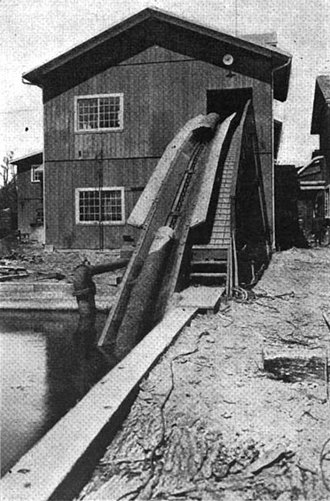Sawmill






Sawmill is a facility where logs are cut into lumber. Modern sawmills use a variety of machinery to cut logs into different shapes and sizes. Sawmills are critical to the wood and forestry industries, providing the raw materials for a wide range of products, from construction materials to furniture.
History[edit]
The history of sawmills dates back to the Roman Empire, with the earliest known sawmill being the Hierapolis sawmill, a water-powered mill from the 3rd century AD in what is now Turkey. However, the widespread use of sawmills did not occur until the industrial revolution in the 18th and 19th centuries. The introduction of steam power and later electricity revolutionized the sawmill industry, increasing production efficiency and reducing physical labor.
Types of Sawmills[edit]
There are two main types of sawmills: portable and stationary.
- Portable sawmills are small, lightweight, and can be transported to a logging site to process trees on-site. These mills are popular among small-scale woodworkers and for custom milling.
- Stationary sawmills are larger facilities that are fixed in one location. They are capable of processing large volumes of wood and typically serve as the backbone of the commercial lumber industry.
Cutting Techniques[edit]
Sawmills employ various cutting techniques, including:
- Band sawing: Uses a thin, flexible, continuous steel strip with cutting teeth on one edge. Band saws are efficient and can make precise cuts with minimal waste.
- Circular sawing: Uses a circular blade to cut logs. Circular saws are fast and can handle large logs, but they typically produce more waste than band saws.
- Chainsaw milling: Involves using a chainsaw to cut logs. This method is often used by portable sawmills for its simplicity and flexibility.
Processes[edit]
The sawmilling process involves several steps:
- Log scaling: Measuring logs to determine their volume and value.
- Debarking: Removing the bark from logs, usually with a machine called a debarker.
- Sawing: Cutting the debarked logs into boards or other shapes.
- Edging and trimming: Removing irregular edges and cutting boards to specific lengths.
- Drying: Reducing the moisture content of the cut lumber, either through air drying or in kilns.
- Planing: Smoothing the surface of the lumber and bringing it to a uniform thickness.
Environmental Impact[edit]
Sawmills have a significant environmental impact, including deforestation, habitat destruction, and pollution. The industry is subject to regulations aimed at minimizing these impacts, such as sustainable forestry practices and waste management protocols.
Future Trends[edit]
The sawmill industry continues to evolve, with advances in technology leading to more efficient and environmentally friendly practices. Automation and computerization are becoming increasingly common, allowing for greater precision and productivity.
| This article is a stub. You can help WikiMD by registering to expand it. |
Ad. Transform your life with W8MD's Budget GLP-1 injections from $75


W8MD offers a medical weight loss program to lose weight in Philadelphia. Our physician-supervised medical weight loss provides:
- Weight loss injections in NYC (generic and brand names):
- Zepbound / Mounjaro, Wegovy / Ozempic, Saxenda
- Most insurances accepted or discounted self-pay rates. We will obtain insurance prior authorizations if needed.
- Generic GLP1 weight loss injections from $75 for the starting dose.
- Also offer prescription weight loss medications including Phentermine, Qsymia, Diethylpropion, Contrave etc.
NYC weight loss doctor appointmentsNYC weight loss doctor appointments
Start your NYC weight loss journey today at our NYC medical weight loss and Philadelphia medical weight loss clinics.
- Call 718-946-5500 to lose weight in NYC or for medical weight loss in Philadelphia 215-676-2334.
- Tags:NYC medical weight loss, Philadelphia lose weight Zepbound NYC, Budget GLP1 weight loss injections, Wegovy Philadelphia, Wegovy NYC, Philadelphia medical weight loss, Brookly weight loss and Wegovy NYC
|
WikiMD's Wellness Encyclopedia |
| Let Food Be Thy Medicine Medicine Thy Food - Hippocrates |
Medical Disclaimer: WikiMD is not a substitute for professional medical advice. The information on WikiMD is provided as an information resource only, may be incorrect, outdated or misleading, and is not to be used or relied on for any diagnostic or treatment purposes. Please consult your health care provider before making any healthcare decisions or for guidance about a specific medical condition. WikiMD expressly disclaims responsibility, and shall have no liability, for any damages, loss, injury, or liability whatsoever suffered as a result of your reliance on the information contained in this site. By visiting this site you agree to the foregoing terms and conditions, which may from time to time be changed or supplemented by WikiMD. If you do not agree to the foregoing terms and conditions, you should not enter or use this site. See full disclaimer.
Credits:Most images are courtesy of Wikimedia commons, and templates, categories Wikipedia, licensed under CC BY SA or similar.
Translate this page: - East Asian
中文,
日本,
한국어,
South Asian
हिन्दी,
தமிழ்,
తెలుగు,
Urdu,
ಕನ್ನಡ,
Southeast Asian
Indonesian,
Vietnamese,
Thai,
မြန်မာဘာသာ,
বাংলা
European
español,
Deutsch,
français,
Greek,
português do Brasil,
polski,
română,
русский,
Nederlands,
norsk,
svenska,
suomi,
Italian
Middle Eastern & African
عربى,
Turkish,
Persian,
Hebrew,
Afrikaans,
isiZulu,
Kiswahili,
Other
Bulgarian,
Hungarian,
Czech,
Swedish,
മലയാളം,
मराठी,
ਪੰਜਾਬੀ,
ગુજરાતી,
Portuguese,
Ukrainian